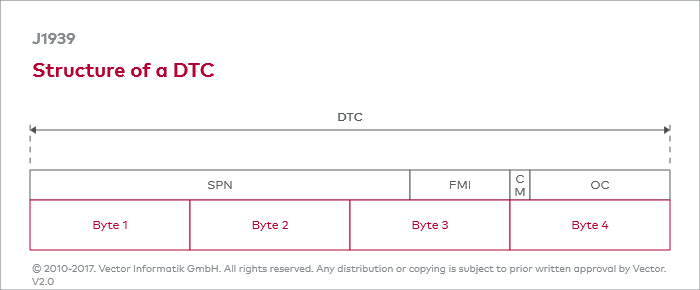- Overview
- 1. Introduction
- 2. General Description of the Protocol
- 3. Document Structure
-
4. Fundamentals
- 4.1. Names and Addresses
- Device Names
- Device Address
- 4.2. Parameter Group
- General
- Structure and Type of a Parameter Group
- Example of a Global Parameter Group
- Example of a Specific Parameter Group
- Parameter Groups reserved specially for the Protocol
- 4.3. Data Management
- Suspect Parameter Number (SPN)
- SLOT Definition
-
5. Network Management
- Network Access
- 5.1. Address Conflict
- Solution and Configurations
- Handling in a Dynamic Network
- 6. Transport Protocols (Multi-packet Messages)
- 7. Diagnostics
Diagnostic Trouble Code (DTC)
DTC
A DTC (Diagnostic Trouble Code) represents a faulty property in the system. It primarily represents an SPN whose current status is abnormal. This can have different causes. An indicator that gives the reason for the status is used to try to narrow down the actual cause of the error. A DTC has a uniform structure and consists of the following elements:
-
Suspect Parameter Number (SPN)
Represents the SPN with error. Every defined SPN can be used in a DTC.
-
Failure Mode Identifier (FMI)
Represents the nature and type of error that occurred, e.g., value range violation (high or low), sensor short-circuits, incorrect update rate, calibration error.
-
Occurrence Counter (OC)
A counter that counts the occurrence of the error condition for each SPN and stores this even when the error is no longer active.
-
SPN Conversion Method (CM)
Defines the byte alignment within the DTC. The value “0” represents the method shown in graphic “Structure of a DTC”. If CM has the value “1”, a distinction must be made between three previously valid methods; this must be known for the system.

